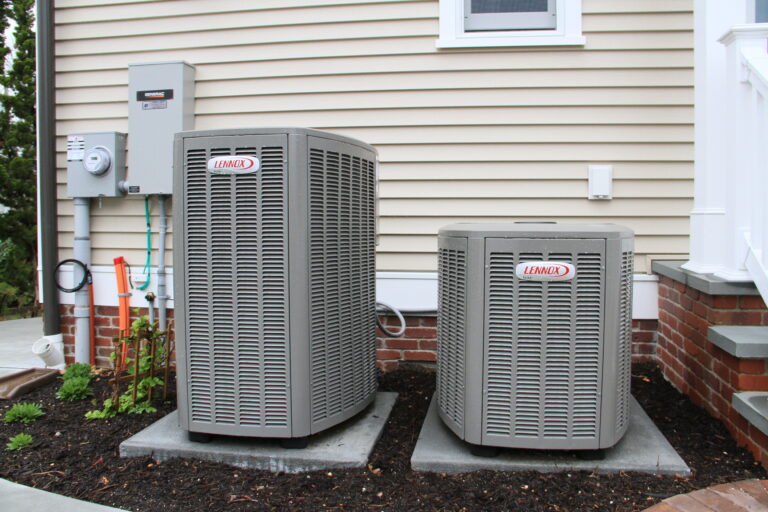Single-Stage vs Two-Stage vs Variable Speed ACs: Which is Best for My NJ Home?
November 11, 2024

We get this question a lot from New Jersey homeowners who are in the market for a new central air conditioner.
The answer? Well, it depends on what you mean by “best”.
If by “best” you mean the AC that provides the most comfort and the highest efficiency, our answer will always be a variable-speed air conditioner. But variable-speed air conditioners are also the most expensive—which forces some homeowners to cross this option off the list.
That said, we usually base our suggestions off of the homeowner’s budget…
- If you don’t mind paying more upfront for higher comfort and lower energy bills, a variable-speed air conditioner is the best option.
- If you’re on a budget, the best option is a two-stage air conditioner.
To help you make your decision, we’ll compare single-stage, two-stage and variable-speed ACs based on:
- How they work
- How much they cost
How they work: Single-stage vs two-stage vs variable-speed ACs
First off, let’s designate the air conditioner hierarchy when it comes to comfort and efficiency:
- Single-stage ACs: ADEQUATE
- Two-stage ACs: BETTER
- Variable-speed ACs: BEST
To explain that, let’s compare the operational mode of each of these air conditioners.
Single-stage ACs
When a single-stage air conditioner turns on, it can only run at 100% capacity. This is why they’re called “single-speed”: they run at one speed only—full blast.
The biggest downfall to only running at 100% capacity is that these units turn on, cool the home very quickly and then shut off. This ON then OFF cycle repeats over and over throughout the day. This process is called short-cycling.
And, because they short cycle so much, single-stage ACs:
- Can’t dehumidify very well
- Have shortened life spans
- Consume a lot more energy (i.e. high monthly energy bills)
- Produce hot/cold spots
- Can’t provide precise temperatures (they often over/undershoot the set temperature by up to 4–6°)
Our advice on single-stage ACs? If you’re on a super strict budget, this AC will “get the job done” but because a single-stage AC comes with high energy bills, we usually try to convince homeowners to spend a bit more upfront for at least a two-stage AC.
Two-stage ACs
When a two-stage AC turns on, it can run at 1 of 2 speeds:
- HIGH: the AC runs at 100% capacity
- LOW: the AC runs at 60–70% capacity
The good news is that, given New Jersey’s relatively mild summer, a two-stage air conditioner usually runs on its low setting over 80% of the time.
Because they run at a lower setting, they also have longer run times—which may sound bad but it’s not!
In fact, because two-stage ACs have longer run times, they:
- Provide better dehumidification
- Live longer
- Need less repairs
- Consume less energy
- Provide more precise temperatures (can cool your home +/- 2–4° from set temperature)
Our advice on two-stage ACs? If you’re on a budget, this is a great option because you get lower energy bills with a two-stage vs a single-stage. Plus, homeowners typically spend less on repairs over the lifetime of a two-stage AC (due to their ability to run on a lower, energy-efficient speed).
Variable-speed ACs
When a variable-speed AC turns on, it can ramp up or down in speed to run at whatever capacity is needed at the time. Think of this like how a car works: you can speed up or down depending on whatever is needed.
Because they run at very low speeds the majority of the time, variable-speed AC’s have long, steady run times, which leads to:
- Powerful dehumidification
- Longer lifespans than single-stage/two-stage units
- Less repairs/breakdowns than single-stage/two-stage units
- Very little energy consumption
- Very precise temperatures (can cool your home +/- 0.5° from your set temperature)
Our advice on variable-speed ACs? Get one if you can afford it! These advanced air conditioners offer huge savings on energy bills, need very few repairs (when used correctly and maintained regularly) and offer the highest comfort levels.
So now that we know how these ACs work, let’s compare how much they cost upfront.
How much they cost: Single vs two-stage vs variable-speed ACs
To help you compare prices, let’s look at 3 different air conditioners and their approximate price:
- ~ $1,795 for a single-stage 3-ton Lennox XC14 AC
- ~ $2,469 for a two-stage 3-ton Lennox Elite XC16 AC
- ~ $2,995 for a variable-speed 3-ton Lennox XC20 AC
Note: The prices above reflect only the cost of the unit itself and does not include installation costs. You can expect to add anywhere from $3,000 to $6,000 to the numbers above for an overall upfront cost (includes the unit, labor, materials, tools, permits, etc.). For more detailed information on AC installation costs, check out our blog, “What’s the Cost to Install a Central Air Conditioner in New Jersey?”.
So you can see that you’d spend around $526 to $1,200 more for a variable-speed AC (assuming the additional installation cost remains the same for all 3 air conditioners).
But remember—variable ACs offer lower monthly energy bills that could pay back that higher installation cost over the lifetime of the unit. Consult an HVAC tech to determine if/when a variable-speed AC would pay back its higher upfront cost given your cooling habits.
Want specific pricing for your AC installation?
Whether you’re ready for an estimate for your AC installation or you still have questions about single-stage, two-stage or variable-speed ACs, we can help.
